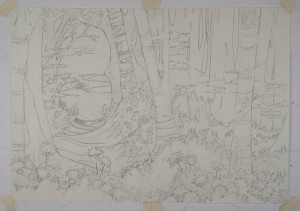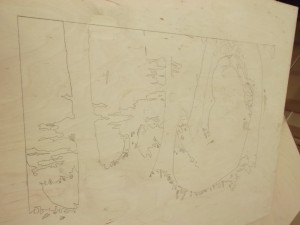I like Brian Cox with his hair and his enthusiasm for describing the Cosmos with the help of an empty beer bottle and a stick, but I was very sorry to hear him dismiss art in favour of science*. If I ruled the world (though better hope I don’t because there would be laws against leaving lights on in empty rooms and the airing of Count Arthur Strong on the radio, ever…) I’d just lump everything under the collective heading of ‘creativity’ and be done with dividing the arts and sciences.
Today I have been mapping out my latest print and it raised a philosophical question for me: was the process art or science? The print is a complex one: a view from inside a shady spring wood out over a bright spring landscape and I confess I did have to switch off Radio Four to concentrate. I’ll describe the process and you decide what was actually going on – maths, art, physics, alchemy?

I begin with a line drawing of the whole image. This I use to trace the separate parts of the design onto wood, creating multiple woodblocks (a block being the area that gets printed, not the whole piece of wood). Each block is printed in turn to form the finished image.
If it were just a matter of splitting the design into a block for each tree, patch of grass, field etc it would simple. However, I am exploiting the fact that I am working with transparent watercolour and can layer washes of colour to build up the image. This is irrespective of the different areas of the design, so the blue of the sky can also be used to create the blue shadows in the wood by cutting a block the full size of the print rather than one the size of the sky. Likewise I can play with building the depth and texture of the grasses and trees by what print surface I leave and what I remove; cutting blocks covering large areas of the print rather than specific subjects. I ink up the woodblocks with brushes, not rollers, so each block can be inked solid, or with bleeds or mixes of colour.
To work this out I hold the image in full colour in my head. Then I mentally pull it apart, like old fashioned animation, into its separate layers of colours and visualise how layers one to fifteen (it’s a big complicated print) look alone and then together in various combinations so that I can work out what part can be printed with one block and what part will benefit from several blocks printed over each other, where the shadows should be deep or sun should dapple etc. Then I delve into my experience of the paper and paints I plan on using, mentally running through how the pigments will actually work (some resist layering and others accommodate it) and what the paper can stand in terms of pressure, over printing and time spent damp. Then I start tracing, making adjustments and changes as I go.

Now I seriously think about it, my process (all art has processes and I’m nothing special) doesn’t fit neatly into ‘art’ and I bet scientist would say the same about themselves. So while you can play the ‘is it art or science’ game with the results of all our labours, isn’t that a bit pointless? Wouldn’t it just be better to mix everything together and value the creativity? I worry about our politicians and their need to push science over art at present. So perhaps best if I do take over world domination – when I’ve finished laying down the laws on radio content and unnecessary illumination, I’ll be changing the education system a bit too.
*
He suggested that ‘we can live without art, but we can’t live without science’ which is a whole other argument (perhaps to have with our early ancestors). What interested me was his need to have a division in the first place.